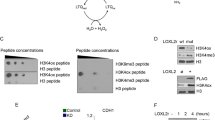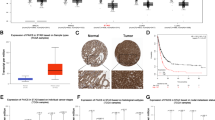Abstract
In humans, the oxidatively induced DNA lesion 8-hydroxyguanine (8-oxoG) is removed from DNA by hOgg1, a DNA glycosylase/AP lyase that specifically incises 8-oxoG opposite cytosine. We analysed the expression of hOGG1 mRNA in 18 lung cancer and three normal cell lines. Although hOGG1 was overexpressed in most cell lines, 2/18 (11.1%) showed a lower hOGG1 mRNA and protein expression (∼80% decrease) relative to normal cell lines. Liquid chromatography/mass spectrometry analysis showed increased levels of 8-oxoG in the two cell lines with the lowest hOGG1 mRNA expression. We examined the ability of nuclear and mitochondrial extracts to incise 8-oxoG lesion in cell lines H1650 and H226 expressing lower hOGG1 mRNA and H1915 and H1975 with higher than normal hOGG1 mRNA expression. Both nuclear and mitochondrial extracts from H1915 and H1975 cells were proficient in 8-oxoG removal. However, both cell lines with the lowest hOGG1 mRNA expression exhibited a severe reduction in 8-oxoG incision in both nuclear and mitochondrial extracts. Under-expression of hOGG1 mRNA and hOgg1 protein was associated with a decrease in mitochondrial DNA repair in response to oxidative damaging agents. These results provide evidence for defective incision of 8-oxoG in both nuclear and mitochondria of H1650 and H226 lung cancer cell lines. These results may implicate 8-oxoG repair defects in certain lung cancers.
This is a preview of subscription content, access via your institution
Access options
Subscribe to this journal
Receive 50 print issues and online access
$259.00 per year
only $5.18 per issue
Buy this article
- Purchase on Springer Link
- Instant access to full article PDF
Prices may be subject to local taxes which are calculated during checkout








Similar content being viewed by others

References
Arai T, Kelly VP, Minowa O, Noda T and Nishimura S . (2002). Carcinogenesis, 23, 2005–2010.
Audebert M, Charbonnier JB, Boiteux S and Radicella JP . (2002). DNA Repair (Amst.), 1, 497–505.
Audebert M, Chevillard S, Levalois C, Gyapay G, Vieillefond A, Klijanienko J, Vielh P, El Naggar AK, Oudard S, Boiteux S and Radicella JP . (2000). Cancer Res., 60, 4740–4744.
Ayala-Torres S, Chen Y, Svoboda T, Rosenblatt J and Van Houten B . (2000). Methods, 22, 135–147.
Blons H, Radicella JP, Laccourreye O, Brasnu D, Beaune P, Boiteux S and Laurent-Puig P . (1999). Mol. Carcinog., 26, 254–260.
Bohr VA, Stevnsner T and de Souza-Pinto NC . (2002). Gene, 286, 127–134.
Boiteux S and Radicella JP . (1999). Biochimie, 81, 59–67.
Cherng SH, Huang KH, Yang SC, Wu TC, Yang JL and Lee H . (2002). J. Toxicol. Environ. Health A, 65, 265–278.
Chevillard S, Radicella JP, Levalois C, Lebeau J, Poupon MF, Oudard S, Dutrillaux B and Boiteux S . (1998). Oncogene, 16, 3083–3086.
Croteau DL, ap Rhys CM, Hudson EK, Dianov GL, Hansford RG and Bohr VA . (1997). J. Biol. Chem., 272, 27338–27344.
Dhenaut A, Boiteux S and Radicella JP . (2000). Mutat. Res., 461, 109–118.
Dhenaut A, Hollenbach S, Eckert I, Epe B, Boiteux S and Radicella JP . (2001). Adv. Exp. Med. Biol., 500, 613–616.
Dherin C, Radicella JP, Dizdaroglu M and Boiteux S . (1999). Nucleic Acids Res., 27, 4001–4007.
Dizdaroglu M, Jaruga P and Rodriguez H . (2001). Nucleic Acids Res., 29, E12.
Dobson AW, Xu Y, Kelley MR, LeDoux SP and Wilson GL . (2000). J. Biol. Chem., 275, 37518–37523.
Gunther T, Schneider-Stock R, Rys J, Niezabitowski A and Roessner A . (1997). J. Cancer Res. Clin. Oncol., 123, 388–394.
Hashiguchi K, Stuart JA, de Souza-Pinto NC and Bohr VA . (2004). Nucleic Acids Res., 32, 5596–5608.
Hodges NJ and Chipman JK . (2002). Carcinogenesis, 23, 55–60.
Hollstein M, Shomer B, Greenblatt M, Soussi T, Hovig E, Montesano R and Harris CC . (1996). Nucleic Acids Res., 24, 141–146.
Hu YC and Ahrendt SA . (2005). Int. J. Cancer, 114, 387–393.
Hyun JW, Choi JY, Zeng HH, Lee YS, Kim HS, Yoon SH and Chung MH . (2000). Oncogene, 19, 4476–4479.
Jaruga P, Zastawny TH, Skokowski J, Dizdaroglu M and Olinski R . (1994). FEBS Lett., 341, 59–64.
Klungland A, Rosewell I, Hollenbach S, Larsen E, Daly G, Epe B, Seeberg E, Lindahl T and Barnes DE . (1999). Proc. Natl. Acad. Sci. USA, 96, 13300–13305.
Kohno T, Shinmura K, Tosaka M, Tani M, Kim SR, Sugimura H, Nohmi T, Kasai H and Yokota J . (1998). Oncogene, 16, 3219–3225.
Kuraoka I, Endou M, Yamaguchi Y, Wada T, Handa H and Tanaka K . (2003). J. Biol. Chem., 278, 7294–7299.
Larsen E, Kwon K, Coin F, Egly JM and Klungland A . (2004). DNA Repair (Amst.), 3, 1457–1468.
Le Page F, Klungland A, Barnes DE, Sarasin A and Boiteux S . (2000a). Proc. Natl. Acad. Sci. USA, 97, 8397–8402.
Le Page F, Kwoh EE, Avrutskaya A, Gentil A, Leadon SA, Sarasin A and Cooper PK . (2000b). Cell, 101, 159–171.
Lightowlers RN, Chinnery PF, Turnbull DM and Howell N . (1997). Trends Genet., 13, 450–455.
Mambo E, Gao X, Cohen Y, Guo Z, Talalay P and Sidransky D . (2003). Proc. Natl. Acad. Sci. USA, 100, 1838–1843.
Mambo E, Nyaga SG, Bohr VA and Evans MK . (2002). Cancer Res., 62, 1349–1355.
Michaels ML and Miller JH . (1992). J. Bacteriol., 174, 6321–6325.
Michaels ML, Pham L, Cruz C and Miller JH . (1991). Nucleic Acids Res., 19, 3629–3632.
Miller SA, Dykes DD and Polesky HF . (1988). Nucleic Acids Res., 16, 1215.
Monden Y, Arai T, Asano M, Ohtsuka E, Aburatani H and Nishimura S . (1999). Biochem. Biophys. Res. Commun., 258, 605–610.
Nishioka K, Ohtsubo T, Oda H, Fujiwara T, Kang D, Sugimachi K and Nakabeppu Y . (1999). Mol. Biol. Cell, 10, 1637–1652.
Olinski R, Zastawny T, Budzbon J, Skokowski J, Zegarski W and Dizdaroglu M . (1992). FEBS Lett., 309, 193–198.
Paz-Elizur T, Krupsky M, Blumenstein S, Elinger D, Schechtman E and Livneh Z . (2003). J. Natl. Cancer Inst., 95, 1312–1319.
Richter C, Park JW and Ames BN . (1988). Proc. Natl. Acad. Sci. USA, 85, 6465–6467.
Sakumi K, Tominaga Y, Furuichi M, Xu P, Tsuzuki T, Sekiguchi M and Nakabeppu Y . (2003). Cancer Res., 63, 902–905.
Sava V, Mosquera D, Song S, Cardozo-Pelaez F and Sanchez-Ramos JR . (2004). Free Radic. Biol. Med., 36, 1144–1154.
Shinmura K and Yokota J . (2001). Antioxid. Redox Signal, 3, 597–609.
Tajiri T, Maki H and Sekiguchi M . (1995). Mutat. Res., 336, 257–267.
Takao M, Aburatani H, Kobayashi K and Yasui A . (1998). Nucleic Acids Res., 26, 2917–2922.
Tchou J, Kasai H, Shibutani S, Chung MH, Laval J, Grollman AP and Nishimura S . (1991). Proc. Natl. Acad. Sci. USA, 88, 4690–4694.
Thomas D, Scot AD, Barbey R, Padula M and Boiteux S . (1997). Mol. Gen. Genet., 254, 171–178.
Viswanathan A and Doetsch PW . (1998). J. Biol. Chem., 273, 21276–21281.
Vogel U, Nexo BA, Wallin H, Overvad K, Tjonneland A and Raaschou-Nielsen O . (2004). Biochem. Genet., 42, 453–460.
Wikman H, Risch A, Klimek F, Schmezer P, Spiegelhalder B, Dienemann H, Kayser K, Schulz V, Drings P and Bartsch H . (2000). Int. J. Cancer., 88, 932–937.
Xie Y, Yang H, Cunanan C, Okamoto K, Shibata D, Pan J, Barnes DE, Lindahl T, McIlhatton M, Fishel R and Miller JH . (2004). Cancer Res., 64, 3096–3102.
Yakes FM and Van Houten B . (1997). Proc. Natl. Acad. Sci. USA, 94, 514–519.
Acknowledgements
This work was supported by National Institutes of Health Grant 5 U01 CA084986-04 titled Early Detection Research Network-Integrated Development of Novel Molecular Markers, and NIH Grant 5P50CA096784-03 entitled spore in lung cancer. Certain commercial equipment or materials are identified in this paper in order to specify adequately the experimental procedure. Such identification does not imply recommendation or endorsement by the National Institute of Standards and Technology, nor does it imply that the materials or equipment identified are necessarily the best available for the purpose.
Author information
Authors and Affiliations
Corresponding author
Rights and permissions
About this article
Cite this article
Mambo, E., Chatterjee, A., de Souza-Pinto, N. et al. Oxidized guanine lesions and hOgg1 activity in lung cancer. Oncogene 24, 4496–4508 (2005). https://doi.org/10.1038/sj.onc.1208669
Received:
Revised:
Accepted:
Published:
Issue Date:
DOI: https://doi.org/10.1038/sj.onc.1208669
Keywords
This article is cited by
-
CRISPR/Cas12a trans-cleavage triggered by cleavage ligation of dumbbell DNA for specific detection of human 8-oxoguanine DNA glycosylase activity
Microchimica Acta (2023)
-
Mitochondrial reactive oxygen species cause major oxidative mitochondrial DNA damages and repair pathways
Journal of Biosciences (2020)
-
MTH1 deficiency selectively increases non-cytotoxic oxidative DNA damage in lung cancer cells: more bad news than good?
BMC Cancer (2018)
-
Deregulation of base excision repair gene expression and enhanced proliferation in head and neck squamous cell carcinoma
Tumor Biology (2014)
-
DNA repair genes polymorphism and lung cancer risk with the emphasis to sex differences
Molecular Biology Reports (2013)


